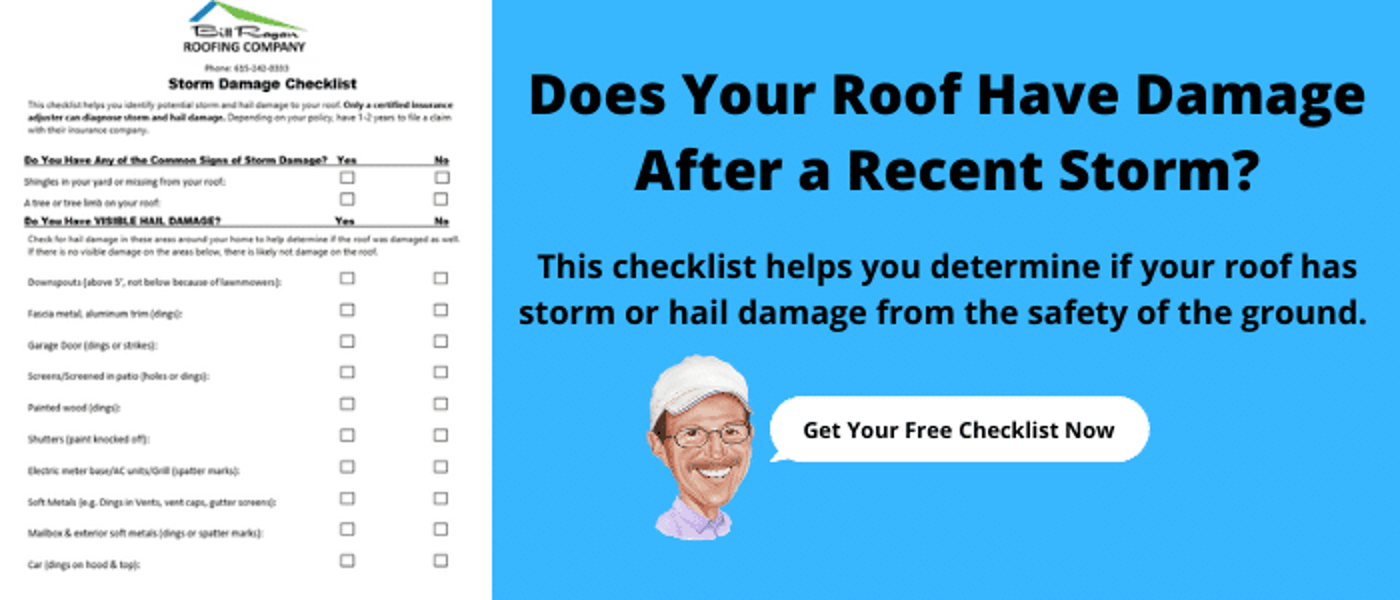What’s Inspected During a Storm Damage Roof Inspection?

So, you just had a strong storm blow through your area. You don’t know if you have damage, but you’re hearing that neighbors around you are having problems.
Now, you’re worried that your roof might have damage after all. While you’ll need to contact your insurance company first, you’ll also need to find a roofing contractor for a storm damage roof inspection.
But what exactly will the roofing contractor inspect and look for when on your property? And how do they prove that your roof has storm damage?
For over 30 years, the team at Bill Ragan Roofing has helped homeowners with their storm-damaged roofs. Now we’ll help you understand what happens during a storm damage roof inspection.
In this article, you’ll learn what a roofing contractor looks for, how they document storm damage, and the next steps after the inspection.
Collateral damage to objects on the ground level
The first thing a roofing contractor usually does is a visual inspection of things at the ground level. They do this to look for “collateral damage” around your property.
Collateral damage means if there’s hail or wind damage in other areas, there’s the possibility that your roof has damage as well.
Below is a list of things and areas that are checked for collateral hail or wind damage from the ground level:
- Dents in downspouts (Above 5 feet, so it can’t be blamed on a lawnmower)
- Dings or strikes to your garage door
- Holes in your window screens
- Dings to any painted wood or shutters
- Splatter marks or dings to your electric meter, AC unit, or grill
- Dents to your mailbox and other soft metals on your property
- Shingles on the ground
- Missing siding
- Granules on the ground by downspouts
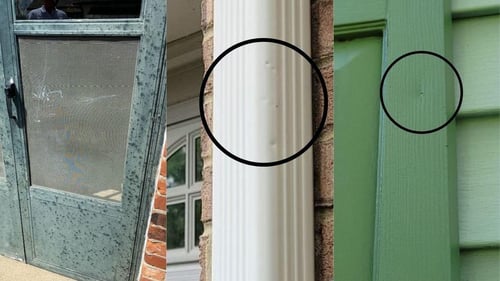 (Collateral hail damage)
(Collateral hail damage)
Keep in mind that it’s not a 100% guarantee that your roof was damaged if collateral damage is found on the ground. However, there’s a good chance you’ll have a claim if any of the above has damage.
What’s inspected on your roof for storm damage?
After inspecting for collateral damage, it’ll be time for your roofing contractor to inspect the roof itself. They’ll look for signs of hail, wind, or other storm damage on your gutters, shingles, and more.
Below are the areas that are inspected during a storm damage roof inspection.
Dents or dings in gutters
When getting on your roof, the roofing contractor will check your gutters for any signs of damage. Like collateral damage on the ground, they’re looking for dings and dents on the face of the gutter.
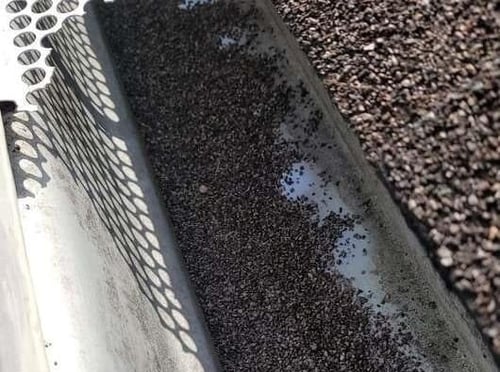 (Granules in gutter)
(Granules in gutter)
They’ll also look inside your gutters for sitting granules. If the hail did enough damage to warrant granule loss, the integrity of the shingles are compromised.
Just know granule loss also happens as a roof ages and is a sign that it’s time for a replacement. So, you may find loose granules in your gutters if you have an older roof that’s just telling you it needs to be replaced.
The condition of your shingles
As soon as they get on your roof, the roofing contractor will inspect the condition of the shingles. For wind damage, they’ll look for any missing, lifted, or creased shingles.
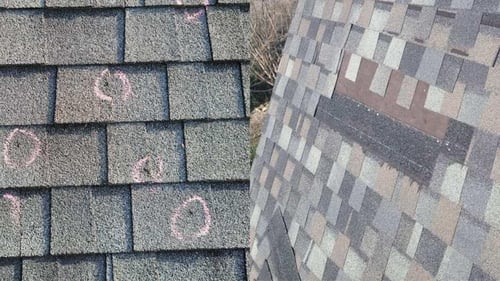 (Left: Hail damage, Right: Wind damage)
(Left: Hail damage, Right: Wind damage)
For hail damage, they look for dings or dents large enough to damage the shingles. They’ll also look for signs of granule loss from hail continuously hitting your roof.
If they find any of the above damage, the integrity of your roof is compromised and should warrant a claim.
Damage to roof flashing and roof vents
After your shingles, the roofing contractor will look at the other components on your roof. The most common areas that show signs of damage are roof flashing and roof vents.
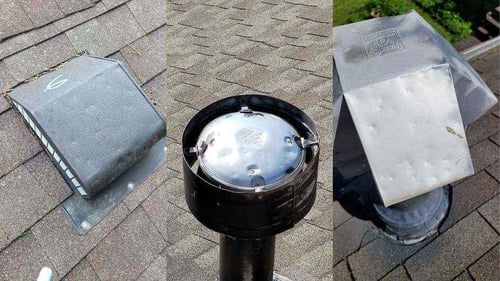
The roofing contractor will look at your roof vents for dents that clearly show signs of hail damage. They’ll also inspect your roof flashing and any other metal on your roof for dents and dings.
If hail was strong enough to dent the metal, your roof will definitely have damage in other areas.
How does a roofing contractor document storm damage to your roof?
During your inspection for storm damage to your roof, the insurance company needs clear evidence that you have a claim. A roofing contractor does this by taking pictures of the damage they notice as proof (if there is any).
This includes collateral damage on the ground and the damage to the roof. They’ll take pictures of any roof areas with missing shingles, granule loss, hail marks, dents in metal, and anything else that looks like possible storm damage.
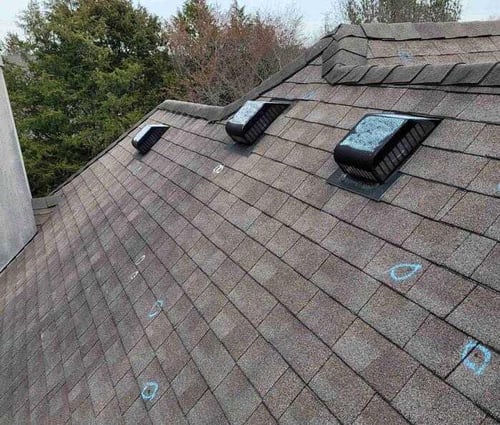 (Chalked up roof showing hail damage)
(Chalked up roof showing hail damage)
To mark the damage on the roof, the roofing contractor uses chalk to point them out. For hail strikes on shingles, they’ll circle the dents and dings on the impacted areas.
For dents on roof vents, they’ll turn the chalk sideways and fill in the area to make the damage more noticeable. After marking up the damage on your roof, they’ll take pictures for submission to the insurance company.
What happens after your storm damage roof inspection?
After getting off your roof, the roofing contractor will show you proof of storm damage and recommend whether or not to follow through with filing a claim. If they didn’t find damage, they’ll recommend not filing a claim and help determine the next option to take care of your problem.
If they find damage, they’ll show you pictures and walk you through what happens next. They’ll also share the pictures to submit to your insurance company.
After that, the ball is in your insurance company’s court to approve or deny your claim. Just know that while your roofing contractor can advocate for you, they have no power to approve your claim.
The only one who can approve your claim is your adjuster and insurance company.
The process for filing a claim for storm damage to your roof
Now you know what’s inspected during a storm damage roof inspection, how a roofing contractor documents it, and what happens after your inspection. If you don’t have storm damage, then great, there’s no reason to move forward with filing a claim.
But if storm damage is found, you’ll be starting a long and confusing process. This is especially true if you’ve never been through it before.
So, it’s important to learn as much as possible before diving in headfirst. That’s why we wrote another article breaking down the homeowners insurance process and everything that goes into it.
Since 1990, the team at Bill Ragan Roofing has provided insurance claim assistance to thousands of homeowners in Nashville and surrounding Middle Tennessee areas. We take pride in guiding you through a stressful process and do what we can to get your problem taken care of.
Check out Homeowners insurance: The process to replace a storm damaged roof to learn what to expect when filing an insurance claim.


